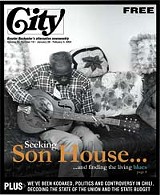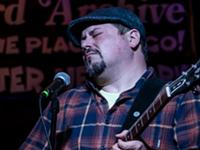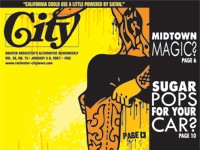[
{
"name": "500x250 Ad",
"insertPoint": "5",
"component": "15667920",
"parentWrapperClass": "",
"requiredCountToDisplay": "1"
}
]
When the Beatles first visited America and were met at the airport by the media hordes, they were asked what their plans were. Paul McCartney's answer included, "I'd like to see Muddy Waters."
A reporter asked, "Where's that?"
McCartney responded, "Don't you even know who your own famous people are?"
This apparent ignorance may seem hard to understand. We now know a lot more about the roots of our popular music. Rock music was still emerging at that time, and the reporter, like many people, wasn't aware that much of British Rock, in fact rock music in general, was heavily influenced by old American blues singers.
Shortly before he was murdered at age 29 --- leaving a total estate of one well-worn guitar --- blues legend Robert Johnson recorded "Love In Vain" and "Walkin' Blues." These two blues classics have since been recorded by the Rolling Stones, Bonnie Raitt, and Eric Clapton.
McKinley Morganfield abandoned virtual slave labor in Mississippi for the blues guitar, reverted to his childhood nickname Muddy Waters, came north to the streets of Chicago, and penned the song "Rollin' Stone" in 1950, when Mick and the boys were still in grammar school.
The list goes on, of old black blues men inspiring young white musicians.
We can take this question of inspirational hierarchy another step: If rock music on both sides of the Atlantic was influenced by the likes of Muddy Waters and Robert Johnson, who influenced Muddy and Robert? Was there someone before them?
In 1981 I was asking myself this very question. I was a newly divorced housepainter-freelance writer. My life was, in many ways, the living blues: unpredictable weather, regular rejection slips, and a steady diet of blues music. I not only listened to the blues, I hosted a weekly blues program on WGMC 90.1 and 105.1 FM. This validated my infatuation with this whole genre of hurting musicians.
I dug through forgotten shelves in the public library, ferreting out old blues recordings for my show. I perused album liner notes, and pored over old music magazines on the microfiche until my head hurt.
There were, indeed, musicians who represented the pre-Johnson-Waters wave of blues. One --- identified by writers across the board --- drove home the point that I didn't even know who my own famous people were.
The man continually hailed as a forerunner in the blues-to-rock evolution, through his influence on pre-World War II musicians like Johnson and Waters, was Eddie J. "Son" House, Jr. What was remarkable to me was that he had lived just across the river from my Gregory Street apartment, in Corn Hill, a thousand miles from the Mississippi plantation where he'd first picked up a guitar.
In a 1950s Down Beat magazine interview, Muddy Waters stated that the biggest musical influence in his life was Son House. As a teenager in the 1920s, Waters would go to hear House sing and play in the roadside juke joints of Mississippi. He approached Son one night between sets and asked if he could join him on stage. House, more than 10 years his senior, told him to come back when he was older.
Robert Johnson also grew up in the shadow of Son House. In his book, Searching for Robert Johnson, Peter Guralnick identifies House as Johnson's closest influence. Johnson made it relatively big, recording in Dallas and performing across the South. He played the open-tuned guitar, like House, and popularized the "walking bass" style of guitar playing, now recognized as the musical hook that drove early rock 'n' roll.
Johnson was poisoned in 1938 by a jealous husband, but Muddy Waters, with his House-style open-tuned electric guitar, lived to achieve world fame in his own lifetime, in an age when radio and mass-produced albums precipitated worldwide emulation by white rockers.
Son House, a singing legend but not a professional visionary, remained in the Yazoo River Delta region of Mississippi, playing at rent parties and chicken barbecues, occasionally recording for the limited "race market." During this time, he was discovered by John Lomax, who was conducting field recordings of authentic American musicians for the Library of Congress.
Then, right around 1940, Son House dropped out of sight.
A generation later, in 1964, college student and blues aficionado Dick Waterman, captivated by recordings of Son House's poignant lyrics and powerful voice, wondered indeed: What did happen to Son House? After his final exams, Waterman jumped in his Volkswagen and headed south for Mississippi, where he drove dirt roads and walked plowed fields, talking to farm workers in search of Son. He uncovered people who had known Son, but no Son House.
Waterman eventually found Son, not in Mississippi, or even the South, but back up north in Rochester's riverfront Corn Hill neighborhood. After driving thousands of miles chasing false leads, Waterman pulled up to 61 Greig Street in Rochester.
In the liner notes for the album Son House: Father of Folk Blues, Waterman describes that 1964 day as a warm, spring afternoon. He walked up to a man sprawled on the front stoop who'd obviously spent much of his life living the blues.
Waterman eyed him hesitatingly, "I'm looking for Son House."
The man worked himself upright, staring at Waterman, and answered in almost question-like form, "I'm him."
Waterman was ecstatic. It's not clear how long it had been since Son had played, but Waterman worked with Son until he was cranking out the blues with a youthful vigor and a matured voice. He arranged for Son to appear at the Newport Jazz Festival in 1965, produced Son's Father of Folk Blues album, and set Son up on a US-Canadian-European tour with Canned Heat.
Then, following the hoopla of Son's rediscovery and a couple of years playing clubs and universities, the story of Son House seems to end again, this time in the mid-'70s. He just up and disappeared.
I'd purchased or taped virtually every recording of Son House's spine-chillingly deep baritone voice and had compiled a pretty complete picture of his life from album jackets and books on music. But nowhere did I find the answer to the question: "What happened to Son House?"
Besides the library, I haunted record stores for blues records to play during my radio show. The manager at Play It Again Sam told me she thought Son House was dead. I assumed she was right, and, distracted by a streak of good weather and several back-to-back painting jobs, I let the question go.
But one night on my blues show, listening to my closing theme music --- Son House's a cappella chant, "Grinnin' in Your Face" --- I realized it would be sacrilegious to continue playing this song without knowing what became of this man. I decided to find his house in Corn Hill. There might be a clue there --- papers left behind, an address....
The next morning found me staring at the empty lot at 61 Greig Street. Son's house was gone. Then I remembered something else the manager at Play It Again Sam told me: John Mooney, a young blues singer from Honeoye Falls, had once been real close with Son. I'd chosen to ignore this information, having ambivalent feelings about younger white men interested in old black blues singers.
I found the John Mooney Blues Band playing 40 miles south of Rochester, in the Naples Hotel, where I cornered Mooney between sets. He was pretty sure Son was alive and, last he knew, living in Detroit. He pulled an address book from his guitar case and gave me Son's phone number.
Two days elapsed before I mustered up the courage to make the call. Son had likely died since he gave this number to Mooney. If not, he wouldn't want to bother with some guy from Rochester. I waited for my housemates to leave before I placed the call, so they wouldn't witness my disappointment or rejection. I paced in the empty kitchen while I listened to the phone ringing in Detroit. A woman answered, in a tone that said she'd already seen and heard it all.
Yes, she was Son's wife. And yes, he was alive. She consented to let me come and interview the then-79-year-old Son for Upstate Magazine, the Democrat & Chronicle's old Sunday supplement. She reluctantly agreed on a date. I said "Good-bye," but instead of responding with her own farewell, she yelled in the phone, "...and they don't allow no geetar playin' here!"
Mark Sampson, introduced to me by a mutual acquaintance, was the only other Rochesterian I'd found who shared my curiosity over the whereabouts of Son House. Mark was a portrait photographer and a student of the blues. He also owned two steel-bodied slide guitars, the type that Son played. Together we headed out one Saturday at dawn with a full tank of gas, a hundred dollars, and enough photographic equipment to shoot "The Complete History of the Blues."
Nine hours later we were rolling down Second Avenue in Detroit. The marquis of an old theater said the Bus Boys --- America's only all-black rock band --- were playing there. We parked in front of a housing project and made our way across the front lawn.
The whole world could probably see what was on our minds. Mark's well over six feet tall, and probably closer to seven with his cowboy boots and hat. Carrying a shiny red metal guitar, camera, and tripod, he was no small spectacle as he went first down the sidewalk and into the lobby of the high-rise. I followed with another guitar and all that mysterious stuff that goes with cameras.
We squeezed onto the crowded elevator where our co-riders --- mostly very old and very short --- were damned if they were going to give an inch.
We reached the fifth floor and backed out of the elevator nodding our apologies to silent, staring faces. The elevator door slid shut and we stood there in the quiet hallway. There it was: right opposite the elevator, number 518, Son House's door.
We looked at each other.
Mark said, "Well?"
I knocked. Through the space under the door I could see the shadow of feet approach the other side of the door and stop. I straightened myself. This was my very last moment to imagine meeting Son House, the man who'd already been discovered more times than America.
The door opened and his wife, Evie, placed herself in the open doorway. "What's in it fer him?" she shot at us, before we could even say "Hello." Her arms were folded in front of her chest, in a tone that said she already suspected the answer, "nothing."
Not prepared for outright hostility, it took me a moment to sputter "recognition." Over her unmoving shoulders I could see into the apartment. Son House sat facing us in a La-Z-Boy chair, hair slicked down, hands resting perfectly on the arms of the chair, shirt pressed, grinning in almost childlike anticipation.
After listening to a few more of my patronizing observations regarding the value of our visit, his wife saw there was no way out and let us in on the condition we be brief.
The Son House who faced us that day did not have the strong, athletic veins that once stood out in his forehead and his neck when he sang, as I'd seen in documentary videos. He didn't seem to be looking inside himself like he did on stage. Nor did he look out and beyond us, his audience of two --- like he did when talking to a crowd, as if talking to someone not in the concert hall but beyond, perhaps back on the Stovall Plantation in Mississippi.
He was thin, his cheeks drawn in, and he looked directly at us as if wanting very much to make human contact. The Son House who faced us that day could barely speak, yet I could see in his twinkling eyes the man who'd jammed with pre-war blues singers Charley Patton and Willie Brown, toured two continents in the '60s with Canned Heat, and jammed again in Rochester in the '70s, with musicians like Joe Beard, John Mooney, Rockin' Red Palmer, Aleks Disljenkovic, Ted Mosher, and others.
This was clearly the man whose penetrating baritone voice was known from Chicago, to London, to Rochester's Regular Restaurant at the Genesee Co-op. The man who for years had no address; the man who didn't discriminate between the components of the living blues: singing, imbibing, panhandling, even pawning his guitar.
That overcast Saturday, the man who once told Muddy Waters to go away and come back in a few years struggled for answers to my questions. Even words. I asked him which countries he'd played in. He said, "Uh, 'A'... it starts with 'A'... uh, Africa."
"Austria," his wife corrected.
A guitar made its way into his hands. Determined to please us, his whole body stiffened in one mighty effort to strike a chord. He shoved his feet straight out in front of him as if he were slamming on the brakes of a car. But the only sound that came from the guitar was a discordant clunk. As his left fingers became jammed between neck and the strings, he winced in pain.
Mark and I were both going to step around the coffee table to his rescue when a small tremor shook his body, like a dying cat I once saw, and a long gob of spit drooled down from the corner of his mouth and splashed off the front of the shiny metal guitar.
Evie, who'd sat quietly on the sidelines like a mother watching a child go through a painful but necessary medical procedure, intervened and now the guitars sat silently on the floor, like ships out of water. No longer musical instruments, but painful indicators of how our self-serving idealism had gone 180 degrees: undoing, rather than summing up Son House's power.
The room fell silent. Mark had already taken pictures. I could hear through the thin walls a toilet flush in the next apartment. The handwriting was on all four walls: our long-awaited meeting with Son House was over.
I was trying to couch a proper goodbye when Son slowly squeaked forward on the worn vinyl, mustered up some strength, and strung together seven words in a rich and powerful a cappella: "Don'tcha my-yind people grinnin' in yo-ho faaace!" --- lines from the very chant I used to open and close my blues program.
I recalled at that moment something John Mooney had told me: "Son didn't sing or play in the house --- his wife wouldn't allow it." Son had just crossed the line for us.
That evening Mark and I crossed the bridge from Detroit into Windsor, Ontario, to take the shortcut through Canada, back to Buffalo, and home again to Rochester.
Mark stuffed a tape in the deck, turned it way up, and proceeded to fall sound asleep. Neil Young was wailing, "Hey, hey, my, my, rock and roll will never die... it's better to burn out, than it is to rust..."
I decided to pull over and sleep for a while. As I clicked my seat back my last thoughts were about Son House. In the words of Rochester blues guitarist Aleks Disljenkovic, Son House's voice was so powerful, "He didn't need a PA system, his voice would pin you to the wall."
I imagined how he might still be singing in that voice, laying down 12-bar blues riffs on his National steel-bodied acoustic slide guitar, laying down rows of goose bumps on the flesh of men and women alike, if he hadn't ruined his life with booze.
We'd wanted to raise Son up out of obscurity and give him the recognition he deserved from the citizens of Rochester, where he lived almost invisibly for three decades. We could do that now. We could tell his story.
We'd also driven to Detroit to show him our appreciation and admiration. I'd selfishly thought if only I could meet Son House and speak to him, I would somehow be rescued from my own life, be more savvy of the world he and I both struggled with. I would have peace.
My needs blinded me from the possibility that he needed me as much as I him. He was one of the most powerful people I'd met. And he was also one of the littlest. That day I reached a new understanding of the blues.
Seven years later, on October 19, 1988, Eddie James "Son" House, Jr. disappeared for the last time, quietly, in his sleep, in Detroit's Harper Hospital. Estimates of his birth date vary, but the most often cited year is 1902. This would have made him 86. He outlived his two notable protégés, Robert Johnson (1911 to 1938) and Muddy Waters (1915 to 1983), and one Beatle, John Lennon (1940 to 1980).
The spirit of Son House is still very much alive. The Corn Hill house Son lived in when discovered by Dick Waterman back in 1964 was across the street from Joe Beard, another Mississippian who came north to find work.
Joe Beard is now a bluesman in his own right. Joe's son, Chris Beard, is a recent Handy Award nominee for Best New Blues Artist. John Mooney, who gave me Son's phone number, lives in New Orleans, where he fronts the Bluesiana Band and is a recent Handy Award nominee for Best Acoustic Blues. Aleks Disljenkovic is a guitarist, and Ted Mosher a bassist, in local blues bands including The White Hots, The Trendsetters, and The Beale Street Blues Band.
For readers who haven't yet discovered Son House, Jeff Harris and Gary Reinhardt will play House's music on their Bad Dog Blues show, WITR 89.7 FM, on Sunday, February 1, starting at 1 p.m.
Speaking of Son House, blues
Latest in Featured story
More by Rich Gardner
-

Lake effect: grapes and the region’s economy
Jan 5, 2005 -

Lake effect
Dec 29, 2004 -
Walking scorched earth
Aug 18, 2004 - More »









